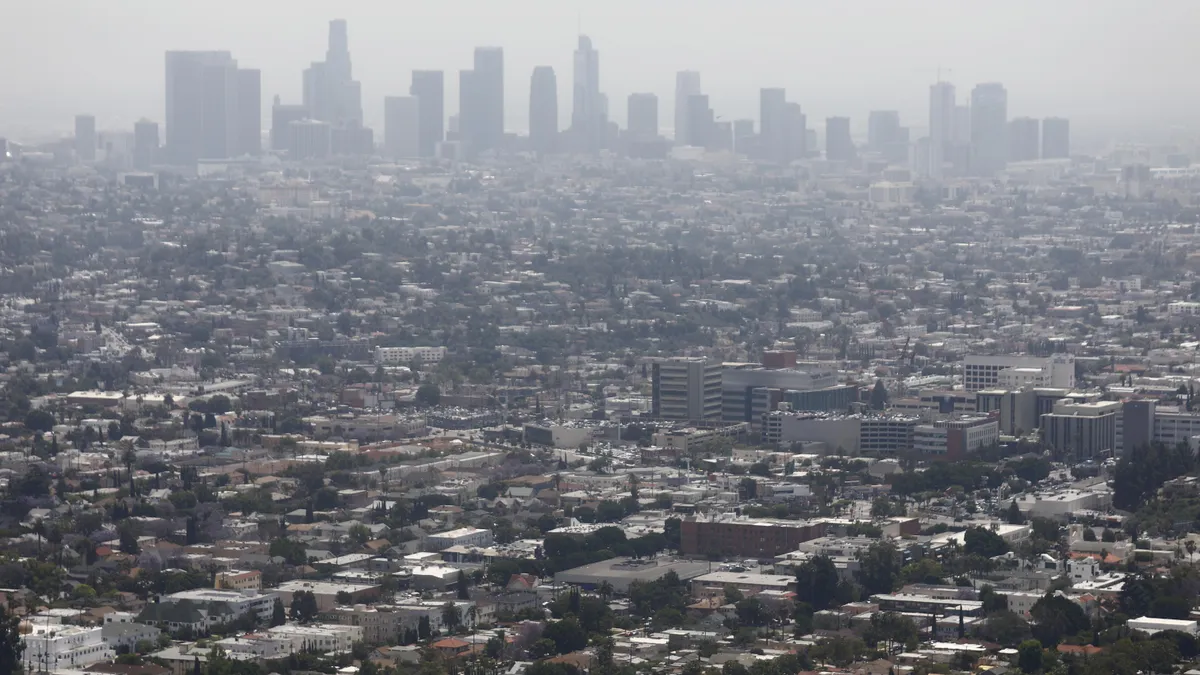Dive Brief:
- To understand how air pollution sources have shifted in recent decades, scientists from the National Oceanic and Atmospheric Administration, NASA and 21 universities in August launched a multipronged research campaign examining North America’s largest cities.
- The research aims to provide state and local officials insight into why two of the most harmful types of pollution — ground-level ozone and fine particulates — have not significantly declined in recent years, even as vehicle and smokestack emissions have lessened due to tighter regulations and pollution control technologies.
- “This is an unprecedented scientific investigation — in scope, scale and sophistication — of an ongoing public health threat that kills people every year,” said NOAA Administrator Rick Spinrad in a statement. Scientists will use satellites, research aircraft, vehicles, stationary installations and even “instrumented backpacks” to monitor air quality.
Dive Insight:
Ground-level ozone — smog’s main ingredient — and fine particulates, which can come from sources such as wildfires, power plants and vehicles, contribute to more than 100,000 premature deaths in the U.S. each year, according to a NOAA press release. Roughly 200 U.S. counties fail to meet federal air quality standards for ozone; 69 counties fail to meet them for fine particulates.
These types of pollution come from volatile organic compounds and nitrogen oxides. While the primary source of volatile organic compounds in cities for many decades was fossil fuel emissions, the landscape has changed. Although emissions from the transportation sector have declined, decades-long downward trends in ground-level ozone and fine particulate matter have slowed recently.
Recent NOAA research points to a new prime suspect for volatile organic compounds in dense urban cities: Consumer products derived from fossil fuels, including paints, pesticides, cleaning products and even lotions and perfumes.
“These may not be properly accounted for in emission inventories or considered in air quality management strategies,” according to the NOAA press release.
The research could also help officials better understand wildfire smoke that has smothered the Midwest and East Coast this summer, NOAA said.
The largest research project in the campaign is called AEROMMA: Atmospheric Emissions and Reactions Observed from Megacities to Marine Areas. The aircraft used for this study will hold 30 specialized instruments to measure gases and aerosols important for both air quality and climate research, Rebecca Schwantes, one of the science leads for AEROMMA, said in an email.
“Additionally, we have an unprecedented number of ground measurements and other aircraft flying [over] the same cities, which adds significant value to the overall dataset,” Schwantes said.
AEROMMA will collect measurements over New York City, Chicago, Toronto and Los Angeles. “Flying such a large aircraft over these urban regions has never been done so far, especially at the scale of this campaign,” Schwantes said.
She noted that Los Angeles and New York City have been investigated in past field research campaigns, but Chicago has been less heavily sampled, especially by an aircraft with such a large number of instruments.
“We are particularly excited to fill in this measurement gap,” she said.
State and local environmental officials were involved in the research’s planning stages to “ensure that the dataset answers questions relevant to them,” Schwantes said. “They are particularly interested in understanding which control measures would provide the largest reductions to both ozone and aerosols.”
“We need to have a better understanding of the current sources of pollutants and what happens to these pollutants once they are in the atmosphere,” said Carsten Warneke, a NOAA Chemical Sciences Laboratory scientist and one of the AEROMMA project’s mission scientists, in a statement.
Other projects in the campaign include research to investigate air pollution in New York City’s underserved neighborhoods and to understand downwind air pollution from New York City to southern New England.











